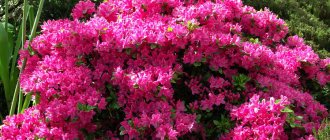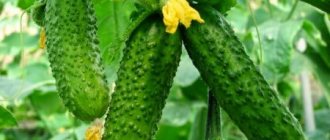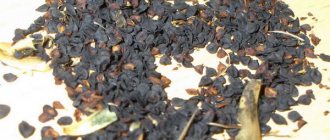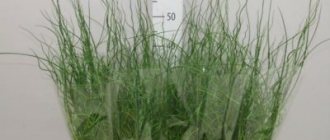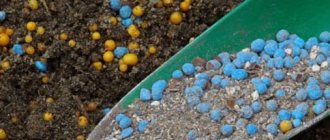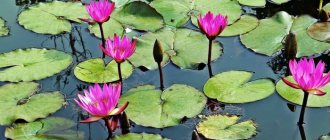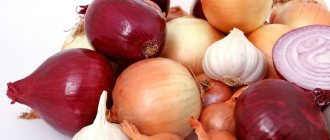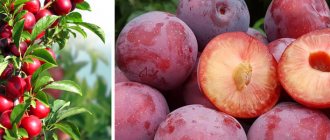Its homeland is East Asia. It grows as a shrub with many shoots.
The height is 2-2.5 meters in natural conditions, although in rooms this figure is more modest - up to 1.5 meters.
The leaves are evergreen, leathery, ovoid, shiny.
There are forms with green, monochromatic leaves, but they are practically not grown indoors.
Aucuba japonica has gained popularity thanks to its more famous form with variegated foliage: yellow spots of irregular shape and different sizes are randomly scattered on a dark green background.
One gets the impression that the whole plant seems to be painted with golden sunbeams. Thanks to this coloring, the plant received the name “golden tree” .
is also called “sausage tree” because its leaves look like sliced sausage.
But in fact, the inhabitants of Japan used the branches of this plant to smoke meat, so when Europeans learned about it, they gave aucuba that name.
The flowers are inconspicuous and do not attract attention, but the drupe fruits are red when ripe and have a diameter of about 1 cm.
There are many of them on the plant, and they give the aucuba additional charm.
Although fruiting of this plant rarely occurs in rooms, it occurs only in the presence of male and female specimens of the plant.
The most popular and widespread species in indoor gardening is the variety Aucuba variegata (or Aucuba variegata).
Types of Aucuba domestica with photos and names
There are about 8 varieties of evergreen plants growing throughout the vastness of the planet, from the Himalayas to Japan. But 2 of them are considered the most popular.
Aucuba japonica
A plant with oval smooth leaves up to 20 centimeters in size. When existing in favorable conditions for the plant, its height can reach 2 meters. During the flowering period, bright red panicles appear.
Fruiting occurs very rarely. Can produce white, yellow, red berries. Regular pruning allows you to form a beautiful crown. The Japanese differs from the other variety in the location and size of the spots and is more common.
Aucuba Himalayan
a plant that can be much less commonly found in home cultivation. It differs from the previous variety in size, shape and color. Its leaves are sharp, thin and dark green with cut edges. The plant develops fast-growing shoots that require pruning.
How to care for aucuba at home?
Keeping aucuba at home is not difficult, because the plant is quite unpretentious. Aucuba, reaching up to four meters in open ground, will not grow above one and a half meters at home, but with proper care it will delight you for a long time.
Temperature. A comfortable temperature for aucuba can be considered 17-19 degrees in summer and 8-12 degrees in winter. Temperatures exceeding 20 degrees or below 7 degrees will lead to the death of the tree. You should also protect your aucuba from hot sunlight. In the summer, if possible, it is worth taking the aucuba out into the air.
As for lighting, aucuba tolerates shaded places quite well, but it would still be preferable to place it in a place open to the sun, for example, on a table or windowsill.
Feeding. Aucuba should be fed in the summer, about once a week with mineral fertilizers. In winter, aucuba is not fed.
The soil. Peat, sand, deciduous and turf soil - this is what the soil mixture for Japanese aucuba should consist of. It is preferable to buy specialized soil in the store, since it will already have the ideal proportions for the tree.
Trimming. To form a decorative crown in aucuba, it is necessary to trim new shoots. This should be done in the spring during the growing season, pinching the tips of the branches, thanks to which the aucuba will send out young shoots.
Watering. It is necessary to water the aucuba throughout the year, but in the autumn-winter period the amount of watering should be reduced. You should not allow the soil to become too dry, but you need to be careful: too much water can lead to rotting of the root system.
Humidity is not important for aucuba, although it is certainly not advisable to keep it in excessively dry air.
Reproduction
In plant growing, two methods of propagation of aucuba are used: cuttings and using seeds.
Propagation by cuttings
Cuttings are propagation that involves the use of apical shoots from last year. For a shoot to take root, it must have at least three leaves.
- The cuttings are placed in a peat mixture or clean sand under polyethylene or glass.
- Weekly you need to moisten the soil and ventilate the container, maintaining the temperature at 22°C.
- Only after the cuttings have completely rooted can they be planted in different pots.
Growing Aucuba from Seeds
Propagation by seeds involves harvesting a fresh crop.
- Male and female individuals growing close to each other are artificially crossed.
- The collected seeds should be sown in the ground, also covered with glass or polyethylene, and placed in a warm part of the room.
- Periodically you need to water the soil and ventilate the container.
- It won't take long for the shoots to sprout. They can be replanted into separate pots only after 3-4 leaves appear on the young plants. But when choosing this method, there is a possibility of loss of varietal characteristics.
What problems can arise when growing aucuba?
Among the pests that can attack a tree, the most dangerous are mealybugs. The risk of infection is especially high in the summer if you take the aucuba into the air. Pests should be gotten rid of immediately after detection, using specialized preparations.
Caring for aucuba at home requires attention to soil moisture, since a large number of problems with this tree most often arise due to excess moisture. Aucuba leaves turn black and the plant may die. In the pot in which the aucuba grows, drainage is required; the soil should not be too dense.
Can I keep it at home?
Aucuba has long been actively used in oriental medicine. The leaves of the plant help with:
- burns;
- frostbite;
They can also be applied to wounds and bruises to reduce pain, disinfect and speed up healing. Plant-based drugs are used to treat gastrointestinal diseases.
Remember that domestic aucuba is dangerous due to its poisonous leaves, flowers and berries. You need to make sure that children do not touch the flower.
If possible, place the pot with the plant higher where the child cannot reach. Talk to your children and explain the dangers. After working with a flower (planting, pruning), you must wash your hands thoroughly with soap. The entry of plant juice into the stomach (intestines) causes inflammation and bloody diarrhea.
How to propagate a flower?
The “golden tree” can be propagated in two ways: by seeds and cuttings. Both methods have their own nuances.
Seeds
When propagating aucuba using seeds, you need to keep in mind that only freshly harvested seed is suitable .
This is due to the fact that aucuba seeds quickly lose their viability, so the grower needs to hurry. To collect seeds, two adult plants of different sexes are needed. Pollination will have to be done manually.
Propagation by seeds:
- Fill the planting container with wet peat and sow the seeds into it.
- Cover the container with transparent film or a piece of glass.
- Place the crops in a warm place, but provide them with regular ventilation and keep the soil moist.
- The first seedlings will not appear soon, this is the main disadvantage of seed propagation.
- As soon as the seedlings have formed 3-4 strong leaves, you need to plant them in a substrate that consists of humus, sand and turf soil (2: 1: 2).
Important! When propagated by seed, seedlings may not retain the varietal characteristics of their parents.
Cuttings
The upper parts of last year's stems are suitable for propagation by cuttings. But keep in mind that in order for the cutting to quickly form roots, it must have at least 3 strong leaf plates.
Cuttings:
- To root cuttings, they need to be planted in sand or peat mixed with sand.
- The top of the seedlings should be covered with a glass jar or a transparent bag.
- Move the plantings to a warm place.
- Water and ventilate the plantings regularly, maintaining the room temperature at +22.
- Rooted seedlings need to be planted in separate planting containers filled with a substrate consisting of humus and turf soil, as well as sand (2:2:1).
History of appearance
The flower was found in home interiors already in the 18th century. The residents of Japan are especially lucky with such a plant, where it grows everywhere, taking part in the annual events of the indigenous population. At first, the export of culture from the country was strictly prohibited - people tried to protect it as much as possible. Even then it was valued for its magical healing properties.
Additional Information! When, somewhat later, the plant appeared in Europe, there were problems with selection: the flower itself was female, and a male was needed for pollination. Robert Fortune, a botanist, after some time, managed to get such a seedling, and the issue was resolved.
Growing difficulties
Aucuba is an exotic plant. To grow well and maintain decorativeness, it needs the right microclimate and balanced care. If containment conditions are violated, a number of problems may arise. The most common consequences of care errors are shown in the table.
Table - Difficulties in growing aucuba
| Problem encountered | Possible reasons |
| The leaves are falling | — Low humidity; - heat |
| The leaves are turning pale | — Too bright lighting; - sunny place |
| Young leaves become smaller | — Lack of nutrients |
| Yellowing and falling of lower leaves | — Natural process; - unsystematic watering; - sudden temperature changes |
| Drying of tips and edges of leaves | — Bright lighting; - drying out of the earth in summer; - dry air in the winter season |
| Black spots on leaves | — Wintering in a warm place; - dry air |
The most common disease we encounter is rot as a result of excessive soil moisture. Treatment of rot - removal of damaged roots, treatment with systemic fungicides.
Unusual properties of aucuba - the influence of the plant on people's lives
There have always been signs and superstitions around the exotic, similar to precious metal, aucuba.
To this day, the bush is considered the strongest amulet of peace in the family and family relationships. Aukuba creates a “microclimate” in the house in which the people living in it feel the cohesion and unity of the family. Positive energy is transmitted from the flower not only to the inhabitants, but also to visitors to the house. Another feature of the flower is its ability to attract wealth and happiness into the home. A person caring for a plant is able to find more strength and confidence in himself, and reveal previously undiscovered potentials. Therefore, experts always recommend giving aucuba to modest, shy, complex and insecure people.
Unique properties of aucuba - video
How to achieve a beautiful crown in Aucuba
If many shoots appear on the trunk in spring, the plant needs pruning. After it it will grow better. In order for the bush to have a beautiful, spreading crown, it is recommended to do pinching.
Replanting adult specimens to preserve decorativeness is not done often - once every two to three years. Young bushes - annually.
Aucuba has a fragile and brittle root system. Therefore, when transplanting, you need to be careful and carry it out using the transshipment method.
In order for the flower to grow intensively and maintain a beautiful appearance, the soil for planting is loose. It is recommended to use a mixture of two equal parts of peat, leaf peat, six turf soil and one sand.
When working with shrubs, it is important to remember about safety precautions: carry out all operations with gloves, do not forget to wash your hands, and avoid getting the juice on the mucous membranes.
Sources
- https://greendom.biz/komnatnye-rasteniya/dekorativnolistnye/aukuba/opisanie-foto-vidy.html
- https://flowersfamily.ru/info/aukuba.html
- https://glav-dacha.ru/ukhod-za-aukuboy-v-domashnikh-usloviyakh/
- https://kaktys.club/uhod/dekorativnye/aukuba
- https://greendom.biz/komnatnye-rasteniya/dekorativnolistnye/aukuba/uhod-auk.html
- https://cvetolubam.ru/aukuba/
- https://domsad.guru/tsvety-rasteniya/a/pic719_tsvet-foto-aukuba.html
- https://pocvetam.ru/komnatnye-rasteniya/aukuba-aponskaa.html
- https://glav-dacha.ru/osobennosti-ukhoda-za-aukuboy-yaponskoy/
- https://ProZvety.ru/katalog-rastenij/dekorativno-listvennye/aukuba-yaponskaya-foto
- https://zelenypodokonnik.ru/kizilovye/111-aukuba
- https://krrot.net/aukuba-domashnyaya-zolotoe-derevtse/
- https://stroy-podskazka.ru/aukuba/opisanie-uhod-razmnozhenie/
- https://komnatnie-rastenija.ru/aukuba-uhod-v-domashnih-uslovijah-foto/
- https://rastenievod.com/aukuba.html
- https://CvetnikInfo.ru/komnatnye-tsvety/aukuba-yaponskaya-osobennosti-rasteniya-i-tonkosti-uhoda.html
- https://MrDachnik.com/aukuba
[collapse]
Peculiarities
Aucuba, also often called the “golden tree,” is familiar to many gardeners as a houseplant or greenhouse plant. It looks unusual thanks to its beautiful leaves covered with golden spots. In nature, it develops in the territories of eastern countries - South Korea, China or Japan. Although there are about a dozen types of aucuba, for home use it is customary to choose only 2 of them - the Himalayan and Japanese.
The Himalayan aucuba reaches a height of 4 meters and is characterized by the presence of serrated leaves. On Japanese aucuba, long 20-centimeter leaves appear, either plain or covered with spots.
A general description of the varieties of aucuba suggests that the culture can resemble both a tree and a shrub. If you do not carry out regular pruning, the maximum height will be 1.5-2 meters. Over the course of a year, the “golden tree” grows by 15-20 centimeters. In indoor conditions, aucuba can live for about 10 years. The leathery leaves grow oval or slightly elongated.
The glossy surface is painted green or red-brown. In some varieties it is covered with a scattering of yellow spots of different sizes and shapes. Aucuba flower is colored red. Small buds form apical inflorescences. Fruiting occurs with red or orange berries.
Diseases and pests
Aucuba does not have effective natural protection against pests . Common types of pests often settle on it: scale insects, spider mites, aphids, mealybugs.
Aphids and spider mites can be removed by wiping all parts of the plant with a saturated soap solution (a piece of grated laundry soap for 1 cup of warm water).
The liquid must be stirred well, then moisten a cotton pad with it and treat the leaves and stems.
To kill mealybugs, prepare a tobacco infusion. For 1 liter of water, take 8–10 cigarettes of tobacco and steep the product for a week. The leaves are rubbed with the prepared infusion for several days.
Replanting after purchase
Aucuba is transplanted into a small pot after purchase. It is necessary to plant in a substrate, suitable soil for ornamental plants or a mixture of turf, deciduous soil and peat (1:1:2). The seedling is planted in slightly moistened soil, which subsequently needs to be compacted a little.
Important! The culture does not need frequent replanting. If the flower is mature, then it is permissible to replant it once every 2-3 years. The roots are very thin and brittle, so you need to be very careful during the process.
Common varieties
The types most often on sale are:
Crotonifolia
Aucuba Japonica Crotonifolia is a fairly lush shrub, up to 3 m in diameter. The foliage is glossy and reaches 20 cm in length. Aucuba Japonica Crotonifolia has a different shape of yellow specks, so there are simple patterns on the leaves. The plant has different male and female specimens. The fruits after flowering are red and oblong.
Hillieri
The foliage is distinguished by narrower forms, monochromatic, jagged along the edge, dark green.
Variegata
Very bright foliage, light green. A scattering of gold spots glitters on it.
Goldiana
Very similar to Variegata, but the leaves are slightly larger in volume.
Dentata
The foliage resembles the Holly crop, bright green with a jagged edge.
Technology of planting and replanting indoor plants
Aucuba loves well-prepared, drained soil. To prepare it you will need the following components:
- turf;
- peat;
- humus;
- sand;
- leaf soil.
When planting a flower for the first time, it is better to immediately choose a larger pot, because under the right conditions the root system grows quite actively. Aucuba is replanted annually, but only if the plant is young. Each subsequent pot should be 5 cm larger in diameter than the previous one.
Older representatives (from 5 years and above) can be replanted no more than once every 3 years. Accordingly, the choice of soil and pot needs to be approached more responsibly. If the plant has been alive for several years and has grown greatly, then it is better not to disturb it at all. Adult aucubas should grow in spacious pots, and in order for the soil to be renewed, you can simply remove the top layer of soil every year and replace it with new ones (5-6 cm).
Aucuba is replanted annually, but only if the plant is young
